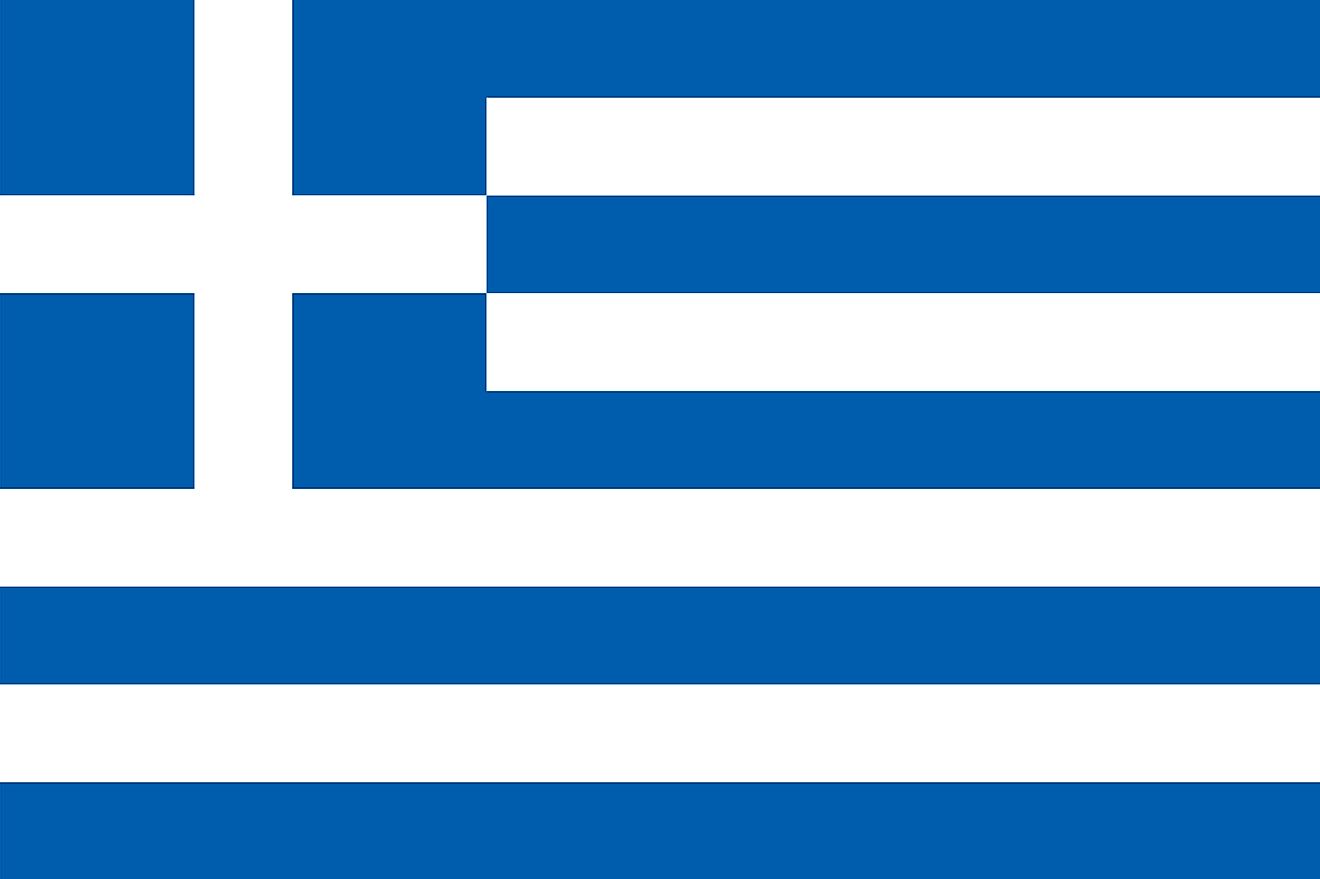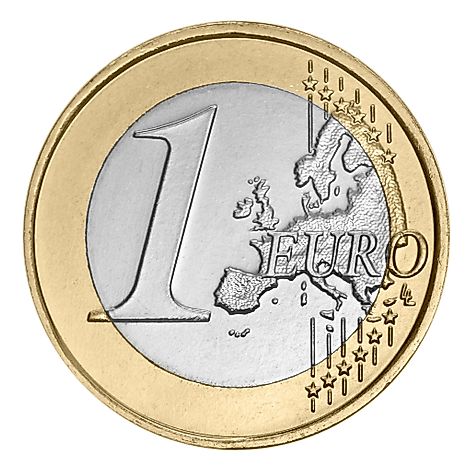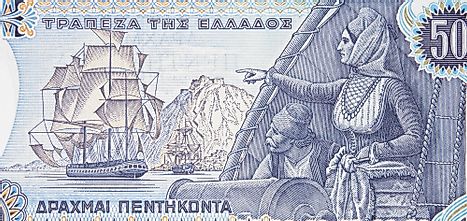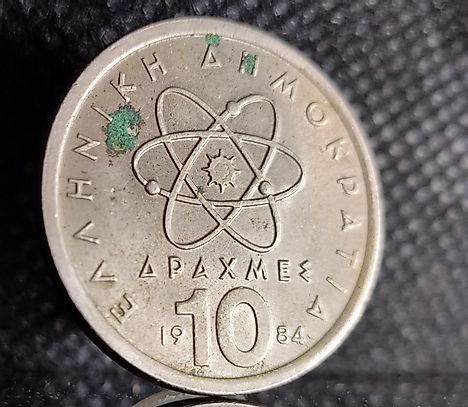Flags, Symbols, & Currencies of Greece

The flag of Greece is popularly referred to as "blue and white." It is one of the national symbols of Greece and was officially adopted in 1822, during the first meeting of the Greek National Assembly. However, the current design was adopted as the national flag of Greece on December 22, 1978. The flag of Greece features nine equal horizontal stripes of blue alternating with white (five blue and four white stripes). A blue square bearing a white cross appears in the upper hoist-side corner. The national flag of Greece has a height to length proportion of 2:3
The features on the flag of Greece carry different meanings for different people. However, the white cross symbolizes Greek Orthodoxy, which is the country's established religion. But there is no agreed upon meaning for the nine stripes or for the colors. According to a popular theory, the nine stripes represent the country's motto: Ελευθερία ή Θάνατος (Freedom or Death)'s nine syllables. However, other sources hold that the stripes represent the nine muses or goddeses of civilization and art. The colors white and blue are often inteprated as colors of sky and sea.
History of the Flag of Greece
The origin of the current flag is still a subject of debate. However, every feature, including the cross, nine stripes, and colors are all historical elements. According to some Greek historians, the flag may have been derived from an older design used by the Cretan Kallergis family. Howevr, during the Ottoman rperiod, several flags, featuring saints and mottoes, were used in Greece. The first blue-cross flag was used in 1769 . However, a white cross on blue background featured prominately in the early 1800s. During the Greek War of Independence, several flags were designed and used by local leades and chiefs. On March 15, 1822, the Provincial Governement described the naval ensign as nine alternate blue and white stripes with white cross on blue. In 1828, the civil ensign, comprising white cross on blue, was discontinued and the naval ensign adopted as the national ensign.
Symbols of Greece
National Coat of Arms of Greece

The national emblem features a blue escutcheon with a white cross totally surrounded by two laurel branches. The current form of the national emblem has been used since 1975. However, several coat of arms have been used in Greece. But, the blue shield with white cross has been the basis for all the arms. The current emblem was designed by Kostas Grammatopoulos, a Greek artist, in 1974. Although the law does not specify the colors of the coat of arms, blue and white have been the popular colors since they appear prominately on the national flag.
National Anthem
- Anthem Title: Ὕμνος εἰς τὴν Ἐλευθερίαν (Hymn to Liberty or Hymn to Freedom)
- Music composer:
- Lyricist: Dionysios Solomos
- Date of Adoption:
The national anthem of Greece is a poetic song written by Dionysios Solomos in 1823. The poem was also used as a national anthem by the Republic of Cyprus. The music composer was Nikolaos Mantzaros. Initially, the anthem consisted of 158 stanzas, making it the world's longest national anthem by text. In 1865, the first three stanzas (later two) were adopted as the national anthem for Greece. The War of Independence inspired the Hymn of Liberty, with the lyrics recounting the sufferings Greek underwent under the Ottoman rule.
Ὕμνος εἰς τὴν Ἐλευθερίαν (Greek)
Σε γνωρίζω από την κόψη
Του σπαθιού την τρομερή,
Σε γνωρίζω από την όψη,
Που με βιά μετράει τη γη.
Απ’ τα κόκκαλα βγαλμένη
Των Ελλήνων τα ιερά,
Και σαν πρώτα ανδρειωμένη
Χαίρε, ω χαίρε, ελευθεριά!
Hymn to Liberty (Hymn to Freedom)
I recognize you by the fearsome sharpness,
of the sword,
I recognize you by your face
that hastefully defines the land (i.e. the land's borders).
From the sacred bones,
of the Hellenes arisen,
and valiant again as you once were,
Hail, o hail, Liberty!
The Currency of Greece is the Euro
The monetary unit for Greece is the euro whose sign is €. The euro banknotes exist in seven denominations: 5, 10, 20, 50, 100, 200, and 500. The circulated euro coins exist in denominations of 1 euro and 2 euro, and the cents are in denominations of 1, 2, 5, 10, 20, and 50. The euro can be used in all the eurozone member states with no need for currency exchange.
Adoption of the Euro by Greece
Greece made an application to join the eurozone in 1999. The country joined the eurozone in January 2001 after being scrutinized and confirmed to have met the convergence criteria. Subsequently, the euro was adopted as the new Greek national currency just like other members of the eurozone. However, the physical currency became available to the Greeks a year later in January 2002. Afterwards, the eligible drachmas were exchanged for euros at a rate of ₯340.75 for every €1. At the time of the euro currency adoption, the denominations of the coins in circulation were 50 lepta, and 1, 2, 5, 10, 20, 50, 100, and 500 drachmae. The banknote denominations were 10,000-, 5,000-, 1,000-, 500, 200 and 100 drachmae.
Public Reception
Most Greeks were positive about the adoption of the euro as the new Greek currency. This was until 2005 when the value of the currency dropped by 26% in February and depreciated by another 20% in June. The future of the euro was uncertain at the time. However, since 2010 the value of the euro has been appreciating. Thus, the citizens of Greece have restored their confidence in it.
Historical Currencies of Greece
Prior to the use of the euro as the currency in Greece, drachma was used as the currency. Drachma was introduced in 1932 and symbolized by the sign ₯. The word was derived from a verb that meant “grasp.” In Ancient Greece, a “grasp” six metal sticks (obeloί) which were used as a currency to facilitate trade. The use of the metal sticks is evidenced by the 150 obeloί displayed as part of Greek’s history at the Museum of Athens. Greek cities that used drachma include Kos, Thasos, Chios, Athens, Abdera, Ephesus, Pella, Sparta, Tarsus, Troy, and Abydos among others. The most widely used coin in Greece was called the Athenian tetradrachm which was commonly referred to as the “owl.” In addition, many world currencies derived their names from the word drachma such as the Armenian Dram, Moroccan dirham and United Arab Emirates’ dirham. An estimated value of drachma in the 5th Century was US$25 which is equivalent to US$46.50 in 2015. The denominations of the ancient dirhma were obol, tetrobol, diobol, didrach, tetradac, and dekadrac.















